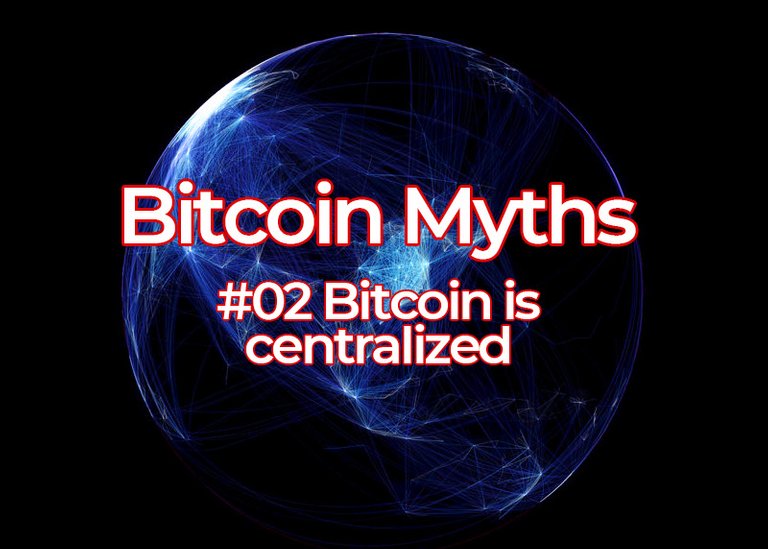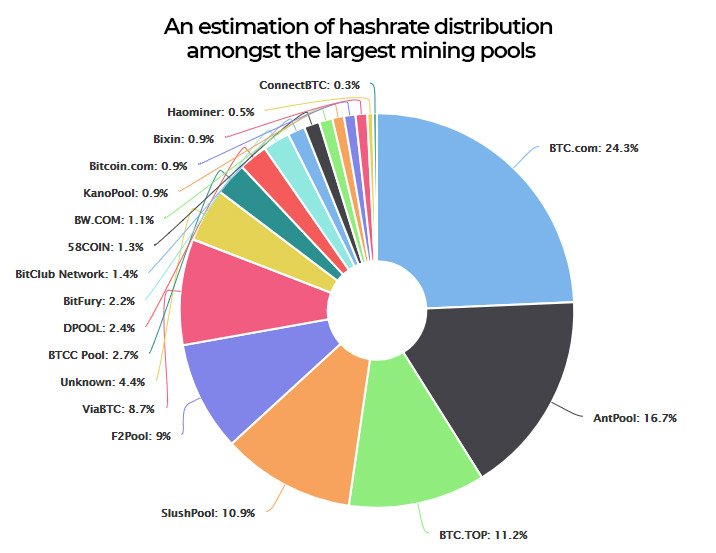
I have heard it said many times that Bitcoin is centralised. This is a very popular lie, which is spread by viola followers. They do this in order to convince unaware people that a given cryptovalent is "better" in this respect than Bitcoin. The exact opposite is true. Bitcoin is the most decentralised cryptalist and there is no doubt about that.
Why is decentralisation so important?
Bitcoin is a distributed network. This means that there is no one or more servers running the network. Instead, the network consists of many identical nodes (full network nodes), which are run by users all over the world. Each of the nodes serves as a "mini server" and has an identical copy of the entire blockchain. This ensures that no one is able to disable such a network or restrict people's access to it. Even a single copy of the blockchain can be used to play back the entire network. The more decentralised a network is, the more secure it is and the more resistant it is to any control or manipulation. All nodes constantly update and verify the correctness of blocks, and announce transactions among themselves.
The speed of distribution of the block between the nodes in the Bitcoin network. Sluggish tempo x4:
What is mining pooles?
You have certainly seen many times the graphic representation of the percentage share of the largest Bitcoin mines:

Currently, the difficulty of digging Bitcoin is very high. With even several hundred of the fastest excavators, the probability that our mine will be able to excavate any block is virtually zero. The solution to this problem is mining pools. With even one excavator you can connect it to a common field. Thanks to this many small mines mine blocks together, as one large mine. If you connect to a field whose power is e.g. 5% of the total hash rate of the network, you will be able to dig the pool every 20 blocks on average. The excavated material from the excavated block is divided into all the mines connected to the pit, commensurate with the percentage of power we lent to the pool. Only a small number of the largest mines make sense to act on their own without being connected to any field.
From the perspective of the network, the whole pool is visible as one big mine. In fact, the pool can be made up of thousands of independent mines. Large and small, scattered all over the world. Pool is only the server that unites all these mines. Most of these pools have servers located in China, so people mistakenly think that three-quarters of all excavators are physically located there. Pooles earn most often on the fact that they charge a small commission of dug bitcoins about 0.5-1% or retain transaction fees for themselves.
As I have already mentioned, this breakdown of mine capacity is misrepresented to uninformed users as a very centralised network. For example, a graphic design comparing EOS to Ethereum and Bitcoin is circulating on the Internet. EOS is a completely centralised project. It will consist of 21 master nodes, which will be specialized servers. Each 128 CPU and 1TB frame. The comparison suggests that the distribution of EOSa is much more even than that of Ethereum and Bitcoin. In fact, EOS will have only 21 nodes, with more than 100,000 full Bitcoin knots.

Risks from controlling mining pools.
Someone may say that the owner of the pool, may use all his power for various purposes. Switch mines to mines such as Bitcoin Casha, dig empty blocks, or use several poles to attack 51% of the network. This is not true. Contrary to appearances, the owners of excavators constantly supervise what they do. The interest is on the verge of profitability. If a given pool would dig empty blocks, or do anything unethical or uneconomical for the owners of excavators, they would quickly switch their excavators to other pools. Changing the field is literally a moment of time, and there are software that automatically changes the field to which the excavators are connected in terms of where it is more profitable to dig at a given moment. If a pool were to manoeuvre the power of users' excavators in the wrong way, it would be very quickly visible and the pool would be discredited and lost users.
Several of the largest pools, such as btc.com and Antpool, belong to Bitmain. Despite this, Bitmain has never used the pool or the power of its users to excavate empty blocks (in order to slow down the bitcoin network and increase transaction fees to show the advantage of Bcash over the original Bitcoin). He used his ViaBTC mine for this purpose.
The most important proof of the lack of power over the network in the hands of the mine was the SegWita soft fork. A year ago, when the users of Bitcoin mostly wanted to introduce SegWit to Bitcoin, most mines were against it. In order for SegWit to implement 95% of its total capacity, it had to give its consent. Unfortunately, only about 30% of the mines were in favour of SegWit. Then the users organized UASF (User Activated Soft Fork), i.e. BIP 148, after implementation of which the user nodes would reject the blocks excavated by the mines that did not support SegWita. The result would be two separate chains and the community would use Bitcoin with SegWit and the mines would mine their own chain, which nobody would use. Despite their advantage and the fact that they had practically all the computing power of the network, the mines surrendered to and began to accept SegWit. As you can see, the number of nods and the community of users had a decisive influence on the development of Bitcoin and not the owners of pools and large mines.

How many Bitcoin's nods are there?
Apart from mines, ordinary users all over the world have full nodes in operation. You don't have to dig Bitcoins to get bored and support the net. Usually we can find the statistics of the number of Bitcoin's nods, such as on the website www.bitnodes.earn.com It shows that there are currently about 10,000 of them.

In fact, there are many more, because only nodes with external IP numbers are visible here. Nodes behind the NAT (e.g. connected to a router, access point), where they have an internal IP number in the subnet, are not visible in such lists. The total number of all Bitcoin nodes is over 100,000 and their number is visible, for example, on the website www.luke.dashjr.org
Bitcoin's users' approach to decentralisation
The Bitcoin community has always taken care of the decentralization of the network, most of all the cryptovalats. For this reason we do not increase the size of the block or the speed of its excavation as other cryptovalats do. Instead, we implement solutions such as Lightning Network and various types of compression of transactions in blocks. It is very important to keep the blockchain as small as possible and the individual blocks as small as possible, so that users will still have multiple knots running in the future and the blocks will be quickly distributed between the knots. I myself have a boredom and I selflessly support the network, as well as many people I know, who are also enthusiasts of Bitcoin. This approach is not found among the users of any other cryptosalver. If you want to support the network, you can download Bitcoin Core from the website: www.bitcoincore.org

I do not recommend that advanced users use this or any PC wallet for bitstream trading. It doesn't matter whether you are using Linux or Windows. The safest thing to do is to use your hardware wallet, or proven wallets under Android or iOSa with special safety precautions. I recommend using Bitcoin Core only as a bottom up.
Congratulations @cyberpunkbtc! You have completed the following achievement on Steemit and have been rewarded with new badge(s) :
Click on the badge to view your Board of Honor.
If you no longer want to receive notifications, reply to this comment with the word
STOPTo support your work, I also upvoted your post!
STOP
Notifications have been disabled. Sorry if I bothered you.
To reactivate notifications, drop me a comment with the word
NOTIFY